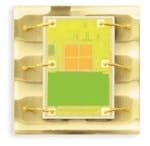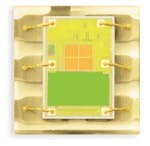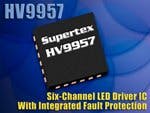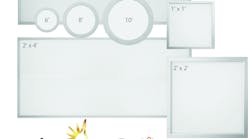LED-based display backlighting continues to be the largest market for high-brightness LEDs despite the fact that the general-illumination application gets more notice. New LED driver and sensor products from Texas Advanced Optoelectronic Solutions (Taos), Supertex and iWatt promise to enable displays with the latest solid-state-lighting (SSL) technology for optimal image quality and minimal power consumption.
Indeed light and proximity sensing is needed in devices based on LCDs to set the appropriate backlight level for maximum display quality without wasting power when ambient light is sufficient or when no one is present to view the display. Taos is targeting mobile devices such as smartphones and tablets with its new TSL2x72 family, although the company also expects the sensors to be used in computer-display and HDTV applications.
The new products include the TSL2572 family for digital ambient light sensing (ALS), the TSL2672 family for proximity detection, and the TSL2772 family that includes both light and proximity sensors.
To serve in mobile applications, the sensors must work in very bright environments and the new Taos products are designed for use in full sunlight at levels to 60,000 lx and beyond. “Mobile device vendors are continually striving to deliver more compelling products with an improved user experience; therefore, they demand ALS and proximity detection solutions capable of operating in a very wide range of lighting conditions,” said Jerry Koontz, TAOS Director of Marketing.
Taos uses programmable signal-gain modes, including a reduced-gain mode, to boost the dynamic range of the light sensors. Meanwhile the company boosted the signal-to-noise performance and added crosstalk-compensation technology to deliver more-accurate proximity detection. Both sensor types can be used sporadically while remaining in sleep mode much of the time to minimize power consumption – especially important in any battery-powered application.
The sensors work with any type of light source including fluorescent and at virtually any lighting level. Moreover the dual-diode architecture can provide accurate results even when mounted behind glass that can distort the spectrum.
Supertex driver handles six strings
Supertex is also targeting battery-powered, mobile devices with its new six-channel HV9957 LED driver. Moreover, the driver offers fault protection features for over-temperature, over current, and over- and under-voltage conditions.
”By providing superior fault protection, HV9957 offers manufacturers a precise LED driver that can handle difficult fault conditions in individual LED strings,” states Stephen Lin, Supertex Vice President of Marketing. “HV9957 also features sophisticated digital circuitry to provide frequency control, fault protection, and phased dimming that is controllable to very low duty cycles for high dynamic range in today’s LED backlighting drivers.”
The HV9957 integrates a switch-mode boost converter and six individual linear low-dropout (LDO) regulators for precise control of each LED string. The driver circuit can supply 30 mA to each LED string, a level typical of battery-powered designs.
iWatt targets TVs with 32-string driver
iWatt, meanwhile, is targeting both edge- and direct-lit HDTV designs with its iW7032 driver that can handle 32 LED strings. The driver uses what iWatt calls adaptive-switching technology to both reduce power consumption and component temperature. Gyan Tiwary, Senior Vice President at iWatt, said, “By overcoming the thermal problems of driving large numbers of LEDs together, our engineers have made a large contribution towards cutting costs for the dynamic backlighting industry.”
The adaptive-switching technology senses the mismatch of the forward voltage of the different LED strings, and adapts that drive current individually for each. The company says that the technique reduces the driver power consumption by 2-5W relative to competitors. The technique both saves power and reduces the heat generated by the driver that in turns extends LED component life.
A single iW7032 driver can power a total of 480 LEDs with stack voltages as high as 56V. The driver also integrates the MOSFETs required to handle the output current to each string. The IC supports three different pulse-width modulation (PWM) schemes with 10-bit granularity for brightness control.
Strategies Unlimited projects driver market
The LED driver market is certainly a significant one as Strategies Unlimited details in a new report on the LED driver market segment. The research firm (like LEDs Magazine a PennWell business unit) projects that driver sales will grow to $3.5 billion by 2015 from $2 billion in 2010.
Strategies Unlimited confirms that display-backlight applications will dominate the market through 2015. But the firm expects general-lighting to be the next major market mover for LEDs and associated technology such as drivers.







